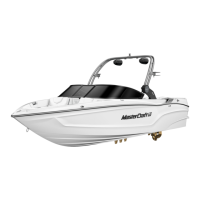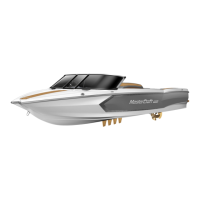sure gauges or indicators, if applicable, should read in the operable
range. There should be no obvious physical damage, rust, corrosion,
leakage or clogged nozzles. Additionally, if the extinguisher has not
been used, it should be weighed annually to assure that the minimum
weight as stated on the label still exists. Any fire extinguisher that has
been partially emptied must be replaced as soon as possible.
In an automatic/manual system, ensure the pin inserted to protect
the system at the helm during transit from the factory (pictured
above) has been pulled to activate the system. This is part of dealer
preparation, but it is the responsibility of the boat owner to ensure
that the system is functional.
FIRE SUPPRESSION
AND EXTINGUISHING
All MasterCraft boats are equipped with an automatic fire suppres-
sion system. The automatic system operates from sensors in the
engine room and will automatically release a clean-agent, gaseous
chemical that does not leave residue behind.
It is also possible to activate the system manually on the domestic
boats only. Pull the pin with the red tag (pictured to left), and then
pull the red fire handle to set the system in operation. (International
boats are automatic only.)
In case of an engine compartment fire, shut down the engine and
blowers before manual discharge, or immediately following the auto-
matic discharge. Boats are equipped with a discharge indication light
at the instrument panel or on the video display gauge at the helm.
After the suppression system has been used, the fire extinguisher
canister will be empty. The boat owner/operator should have the
canister replaced as soon as possible.
MasterCraft boats have also been specified to carry a hand-held 2.5
lb. monoammonium phosphate expellant (dry chemical) unit, which
is rated Class A (trash, wood and paper), Class B (flammable liquids,
fuel, gas) and Class C (energized electrical equipment). These units
should be used in situations other than engine compartment fires.
Hand-held units should be replaced or recharged as soon as
possible after use. Chemical discharge should be cleaned from all
surfaces as soon as possible and prior to running the boat again,
unless operation is necessary to return to shore.
The boat should never be operated following a fire until after a
determination has been made whether operation may result in an-
other fire. If any danger of an additional fire exists, the boat should
be towed to shore or dock rather than running the engine(s).
Consumers who choose to purchase fire control equipment from
resources other than MasterCraft must follow the instructions and
requirements as listed within the engine compartment regarding
suitability for the compartment volume. These standards are estab-
lished by the Coast Guard Code of Federal Regulations (CFR) and
the American Boat and Yacht Council (ABYC).
2021MCOwnerManualFINAL.indd 15 8/26/20 1:51 PM

